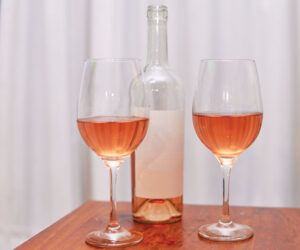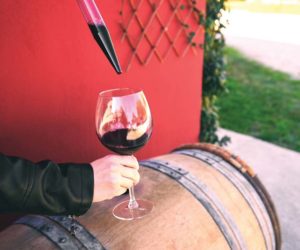
Q
One of my favorite batches is a 2002 Merlot, which was naturally fermented (no added sugars or yeast), aged in an oak barrel for 10 months or so, stored in stainless kegs for six months, then filtered, polished and bottled in early 2004. I would pass out bottles to everyone, boasting of my winemaking skills, and everyone was very complimentary of the taste. Since I had 350 bottles of my Merlot in the garage, I thought storing the wine in an ideal wine locker (55 °F or 13 °C with 70% humidity) would preserve it. Unfortunately, after several months of storage, the wine has a different odor and taste, not to my liking. Did I just ruin my Merlot? Can this be bottle shock? I’m thinking I should have just left the wine in my garage. Is it possible this may be part of the aging process? Please help. I’m in the process of building a temperature-controlled wine cellar, but this experience is making me second-guess my intentions.
Chris Ferrari
San Jose, California
A
It’s hard to say “what went wrong” in this situation as the life of every wine is a fog of carefully guarded secrets that even my scrying glass can’t penetrate. However, the one thing that sticks out for me in your telling above is the drastic change in environment from your garage to the wine locker. In my experience, it’s better to keep wine, in barrel or bottle, in a constant set of conditions, even if the temperature and humidity is a bit above or below the “perfect” digits.
In contrast, your bottles could just be going through what we call a “dumb phase,” which often happens during the aging process. Every wine has a life cycle and, like humans, often aren’t at their peak when exposed to stresses like moving or a drastic change in the weather. I suggest waiting a couple of months to see if your wine experiences a change in attitude.
With respect to your plans to build yourself a wine storage cellar, I say bravo! Go ahead with your plans with 55 ºF (13 °C) and 70% humidity as the goals and don’t worry about those numbers being the cause of your problems. You’re setting yourself up for some good wine storage conditions, which your wines will appreciate all the more when there from the outset.
Q
I’ve made Norton for a few years. This year I noticed an oily film on top before I racked. It smelled and tasted decent. What should I be worried about and how do I fix it? The acid is 0.95 and pH is 3.91. What should I do to lower the pH with out raising the acid?
George Ritchie
Baltimore, Maryland
A
Norton is a fun variety of red wine to make and certainly is a big favorite in the Midwest. I’ve tried some good Nortons over the years and I can share your worries over the wine’s high acid levels. However, before I get into that, let me address your first problem. It sounds like you had an infection of film yeast on top of your finished wine, which often (before the population gets too high and more noticeable) manifests itself as an oily plaque or film. These heterogeneous populations of yeast (undoubtedly with some bacteria mixed in) are aerophilic and therefore love to live on top of the surface of wine in storage containers, where there is air in the headspace of a carboy, barrel or tank. Though the wine may have smelled and tasted fine at the time, film yeast, if allowed to grow, can contribute spoilage aromas and flavors in finished wine, especially if they are allowed continued access to oxygen.
Luckily film yeast are relatively easy to control. Your two best weapons against this kind of microbial bloom are completely topped-up containers and adequate SO2 (sulfur dioxide) levels. Depending on the pH of the wine and the time until bottling, most winemakers agree that during storage, red wines need between 25–40 ppm of free SO2. However, as the anti-microbial and antioxidant properties of SO2 are pH-dependant, higher pH wines, like yours, need higher levels of free SO2 to keep healthy. Also, most microbes tend to be happier at a higher pH, especially bacteria. It is almost certain that the high pH of your Norton wine contributed to the plaque of microbes that you have encountered.
Adjusting the pH without changing the total acidity, or TA, is a difficult thing to do and one that even professional winemakers try to avoid. They mostly get around this sticky problem by making sure that the initial must is within desirable specifications at the outset. However if the vineyard had a high potassium content you can get a situation much like yours, where the pH will be very high (not very acidic) whereas the total acidity, or TA, will be high as well. Usually the situation is the opposite, whereas a high TA translates to a correspondingly low pH.
When possible, rather than mucking about with a wine and potentially ruining it further, blending is often the best option. I don’t suggest trying to lower the TA by using potassium or calcium carbonate because the pH is already so high — your wine would be in even greater danger if it increased. Similarly, it’s not advisable to add acid to try to lower that pH because it would likely require a large addition, and a consequent large rise in TA, to move the pH back into the realm of sanity.
The only thing I can think of that might help is one that I’ve only heard of and haven’t done myself — adding phosphoric acid, familiar as an ingredient in many cola beverages and available through chemistry supply houses. I’ve been told (by those of my winemaking associates who go in for such histrionics) that it lowers the pH without raising the total acidity. Adding phosphoric acid is illegal for commercial winemakers but for those of you who feel the need, 0.05 mL/L of 80% phosphoric acid added to fermenting must, when the pH is 3.90–4.20, seems to do the trick. For finished wine I would have to say you’d probably need a lot less and indeed if you have access to a pH meter I suggest trying it out on the bench first. Also be warned that 80% phosphoric acid is strong stuff and should be handled with the appropriate safety goggles and gloves (and preferably, by those with experience). Like I said, I personally don’t recommend it and strongly suggest blending instead. Why subject your poor wine (and yourself) to a strong chemical treatment when blending is easier and natural?







